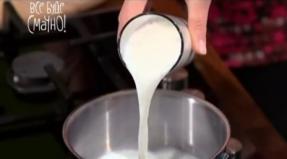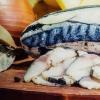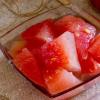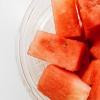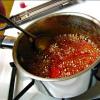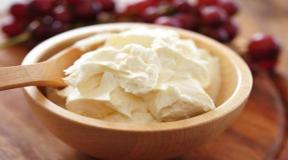Cooking Japanese food. What do the Japanese eat in everyday life?
Bright and extraordinary for many Europeans, it has a long history, counted over the centuries, its own and unshakable. Perhaps, it is precisely a model of originality, diversity and usefulness, which is why it came to the liking of people living in different parts of the globe. In order to better feel all the subtleties and, it is necessary to turn to its history, which goes back many centuries.
Japan is a country with rich flora and fauna, which means that since ancient times it was not a problem for the inhabitants to get enough food for a normal existence. Even many centuries ago, they had about 20 species of various plants in their diet, could cook food from more than 120 types of meat, and also made dishes from several varieties of fish and shellfish.
It is important to note that natural refrigerators were used to preserve food, i.e. pits, the depth of which reached three meters, and salt was also used as a preservative. They smoked the meat, which needed to be preserved for a long time. Archaeologists who excavated in Japan were surprised at how well ancient people knew about the properties of foods used in food. For example, the poisonous Fugu fish, popular in modern cuisine, was in the diet of the ancient Japanese. At the same time, they knew very well that not the whole carcass is a health hazard, but only the liver and caviar, which contain a deadly poison.
Nowadays, many people associate Japanese cuisine with rice, considering it a staple. An interesting fact is that the cultivation of rice crops in Japan dates back to the 3rd century BC. After a short period of time, this product became the basis of Japanese cuisine, forming the gastronomic characteristics and preferences of the inhabitants of the land of the rising sun. At that time, rice performed two main roles - it was one of the main products on the table of every Japanese, and at the same time served as a currency for both internal and external payments.
It was rice that, even before the end of the 19th century, was considered a measure of reward, and its reserves determined the degree of a person's wealth. Every year every inhabitant of Japan eats "koku", i.e. about 180 liters of rice. The passage of time is inexorable, but, nevertheless, it is rice that remains the basis for Japanese dishes to this day.
The main secret of Japanese cuisine
It is currently increasing every day. This is largely due to the fact that the Japanese treat food and food in general from a philosophical point of view. The main rule to be followed is that food must be healthy. In many ways, this is what determines the high life expectancy of this people.
From any other undeniable. Even for residents of neighboring countries, for example, Asian ones, it is original, as, for example, French cuisine is for Russians. The secret lies in the correct approach to the choice of products, the beauty of serving dishes and the attitude towards food in general.
According to Japanese philosophy, exceptionally the best and selected gifts of water and earth are worthy of honor on the table, while the main goal of the chef is to preserve the original useful properties and taste of the prepared products.
The main rule for cooks is “do not create, but find and open”, because no professional in the world can compete with nature itself and its masterpieces. Thus, any excess in relation to the nature of the product is regarded as barbarism.
One of the main features of Japanese cuisine is that all dishes are tailored to a specific situation. So, a real Japanese chef always takes into account the type of food, the time of its intake, weather conditions and even the age of those who are going to eat. That is why in the winter season Japanese food assumes an increase in the portion, and in the summer - a decrease. At the same time, young people are entitled to larger portions, and older ones - less.
It is also interesting that in accordance with these rules, people living in the north of Japan eat more food every day than people living in the southern regions. And it is also part of the culture of Japanese cuisine, which can be better understood by learning more about its main ingredients.
Ingredients
Rice
As already mentioned, the basis of many Japanese cuisine dishes is. The cultivation of this culture began more than 2500 years ago, and continues to this day, therefore, in Japanese, rice is synonymous with the word "food". Currently, there are over 200 varieties of Japanese rice that are used to prepare national dishes. They all have one thing in common - a high degree of stickiness during cooking. It is this kind of rice that forms small lumps when cooking, which are convenient to eat with chopsticks.
It is important to note that it is boiled or steamed rice that is the basis for many dishes and is included in the daily diet of an ordinary Japanese. A wide variety of dishes are prepared from this product, both for breakfast, lunch and dinner. The only difference is with what exactly this rice is eaten. So, traditionally, for breakfast, the Japanese eat loose rice (gohan) with pickled cucumbers or bean soup, for lunch - with boiled vegetables and dried fish, and for dinner - with raw fish and strong meat broth. Also, amazingly delicious sweet desserts are prepared from rice, which are eaten with pleasure not only by adults, but also by children.
The preparation technology of which is similar to the method of brewing beer. However, the percentage of alcohol in sake is three times higher than the "degree" of beer. Thus, we can safely say that rice is the basis for all Japanese specialties and drinks. Despite the fact that the procedures for growing rice are quite laborious, it is this plant that gives the greatest yield. This fact allowed Japan to remain one of the most densely populated countries on Earth for centuries.
Fish and seafood
Second most important in Japanese cuisine Today, seafood is used, and not only fish and shellfish, but also algae are used for cooking. There are three options for serving seafood: boiled, stewed or raw. Much less often, i.e. dishes under the general name "odori".
The method for preparing dishes from live fish is as follows: it is scalded with boiling water, then cut and immediately started to eat, seasoned with traditional sauce. Often fish dishes are complemented by delicate seaweed salads. Algae has also become an ingredient in many soups. The role of algae in Japanese cuisine is irreplaceable, because this product, along with its low calorie content, contains a lot of vitamins and nutrients necessary for the normal functioning of the human body and brain function.
Legumes and vegetables
Soybeans and beans occupy the third position on the podium in the importance of Japanese cuisine. These foods are rich in protein, which is so essential for people involved in manual labor. Legumes allow you to quickly get full and not feel hungry for a long time.
An interesting fact is that soybeans and beans were not originally the main products of Japanese cuisine, because they were borrowed from the recipes of Chinese chefs. It should be said that vegetables and plants play an important role in the culture of Japanese cuisine. The most common vegetables used for cooking are onions (there are several types, for example, golden round tamanogi, white narrow and long bow Hosonegi), cucumbers, carrots, lettuce, cabbage, and vegetables, which are a delicacy for European countries. For example, Japanese is widely used horseradish (wasabi), daikon - white radish as well as lotus.
On the basis of sauerkraut, for example, radish, garlic, cucumbers and cabbage, not only side dishes are made, but also exquisite sauces. Vegetables in the preparation of Japanese cuisine are not only used as ingredients, but are also used for decoration. The variety of shapes and colors allows you to make a real work of art out of each dish.
Japanese noodles and meat
In some cases, instead of rice, when cooking, pasta is taken, or rather, noodles. One of three types is most commonly used: bale, udon or soba... Their difference is that eggs are added to some types of noodles, while others are not. The preparation of this noodle is based on the use of wheat, and less often - buckwheat flour. Noodles are usually served either as part of a soup or as a separate dish, complemented by fish or meat.
It is worth saying that it also implies the presence of meat dishes - beef, lamb or pork. However, this trend appeared not so long ago, and was borrowed from European and Chinese cuisine. Meat products are usually stewed, brightening the taste with various sauces or seasonings.
Japanese food main dishes
Despite the fact that Japanese cuisine is based on a very limited range of products, there are thousands of recipes that are not alike. And, if it takes several hours to prepare some of them, then a professional chef can create others, no less tasty, in just a few minutes.
Rice dishes
So, the simplest, but at the same time nutritious dish is considered to be simple boiled rice. It is important to note that it is prepared without adding any spices or seasonings, even the use of salt is unacceptable. But this only applies to traditional Japanese rice, which serves as an independent dish. For those who prefer a wider variety of flavors, there is a preparation of rice with curry sauce and vegetables. Such a dish is not only healthy, but also has an amazing delicate taste.
Many people also like to include boiled rice with eggs in their diet, because It is a nutritious meal that takes just a few minutes to prepare. Chaofan is considered to be more refined, in a sense an analogue of the usual pilaf. To prepare it, you need to fry rice with pieces of pork, chicken, vegetables or seafood, adding a small amount of oil. At the same time, any seafood or meats can serve as a "filling" for rice.
Sushi, rolls and sashimi
The main delight of Japanese cuisine is raw fish dishes, the most popular of which (not only for Japanese, but also for residents of European countries) is this. For cooking, the fish is not subjected to heat treatment, this is necessary to preserve its natural taste.
- this is a whole science, because for a given dish it is necessary not only to cook rice in a special way, but also to be able to correctly arrange the dish. In Japanese cuisine, this dish is divided into two main subspecies: and. The difference lies in their preparation method. Sushi Is a small oval-shaped lump of rice, on which seafood is placed. In some cases, they can be secured with a thin strip of algae.
In turn, when preparing rolls, it is necessary to lay out seafood and rice in layers on a sheet of algae, then roll it into a thin dense roll and cut it across into slices.
Currently, the range of dishes is constantly expanding and many lovers have appeared sashimi, i.e. thinly sliced raw seafood served on a flat plate with sliced vegetables. Fish, octopus, squid, etc. can be used as seafood for the preparation of this dish, and the vegetable "pillow" traditionally consists of cucumbers, white radishes, etc.
Seaweed, warm and cold salads
They deserve no less respect and Japanese cuisine salads, they can be conditionally divided into three main types.
The first is warm salads that combine vegetables and seafood, slightly warmed up over a fire. Usually these salads are seasoned with special sauces.
The second type of salad is cold, most often consisting solely of vegetables, such as cabbage, ginger, radish or cucumber, seasoned with soy sauce.
The third variety of salads is various variations with seaweed, using different varieties of it. When preparing seaweed salads, either one or several varieties can be used at the same time.
Invariably, such salads are complemented with savory sauces made with ginger, wasabi and nuts.
Soups and broths
For lunch, as well as dinner, many Japanese people like to eat soups, which are usually made with seaweed, beans, or soybeans. The broth can be either fish or meat. Also, soups are often complemented with shiitake mushrooms and delicious tofu, which is obtained from beans. These soups are usually quite spicy and nutritious.
Tableware and accessories
A special role in the culture of Japanese cuisine is played by utensils, with the help of which dishes are prepared and the table is set. In their work, professional chefs use special pans, as well as pots that bear the name donabe and agemono nabe.
The main feature of the frying pans, which bear the name tamagoyakiki, is their shape - square or rectangular. They are most convenient for frying traditional Japanese omelettes because with their help, you can create an amazingly thin and airy omelet, which can later be easily given a cylindrical or cubic shape. Often omelets are used to create, accordingly, the rectangular shape of the frying pan allows you to make an omelet that can be easily rolled in without breaking their standard shape.
All frying pans differ in their size, on average, it is from 10 to 35 centimeters. The material from which the pans are made is aluminum, copper coated with tin or cast iron. An interesting fact is that it implies the use of thick wooden lids, not glass. The lid serves as an additional tool in the kitchen, as it can be used to turn omelets.
If we talk about pots, then it is worth noting some features. donabe... It is made from a special durable type of clay, because in the future food in it will be cooked over an open fire. On the inside, the pot is most often covered with glaze, and the outside is not processed, i.e. remains porous.
An important feature of donabe is its long service life, even with daily use, such dishes can regularly serve for several decades. Special attention is paid to dishes in Japanese cuisine, which is why donabe, in which food was prepared many years ago, are used only to create dishes for guests of honor.
Another pot received no less popularity - agemono nabe, which is used for deep frying of dishes. It has fairly thick walls and is made of cast iron and brass. A small amount of oil is poured into the bottom of the dish, after which they begin to prepare various dishes, for example, beef or pork.
This pot is most often used in conjunction with special Japanese chopsticks that have metal tips. Also, when preparing dishes in agemono nabe, they use an ami shakushi ladle and a special tray for fried dishes. This tray is often used for table setting.
Table setting
In the story, one cannot fail to mention the culture of table setting. It is safe to say that it is the special setting and methods of serving dishes that make Japanese cuisine so attractive to many.
So, for example, serving rules imply the alternation of round and square dishes on the table. At the same time, dark tones prevail in the dishes, for example, black, red or gray. This is no coincidence, because snow-white rice looks even more beautiful and appetizing against a dark background.
It is also worth noting that each type of food involves the use of certain utensils. So, for example, many loved ones serve on rectangular wooden trays, salads and soups - in pots or bowls made of clay (such dishes allow you to maintain the required temperature of dishes), and noodles are placed on the table in special shallow bowls covered with a wooden lid.
However, the main dishes are plates. Modern Japanese cuisine culture involves the use of plates of any shape. Some of them have a curved shape, others have a vertical side, and still others have internal partitions. Partitioned plates are convenient when you need to serve a dish consisting of several components, which you do not want to mix.
Also, this is used in the event that one or more sauces are attached to the dish, which to eat or not, everyone decides for himself.
It is important to note that the main property of Japanese cookware is its convenience. Sauce bowls and cups can be easily held in one hand, plates are compactly placed on the table, and bowls and bowls keep the temperature of the served food well.
Basic principles of serving dishes
Of course, all these rules are not accidental, because they are part of Japanese culture, according to which a person should receive pleasure when eating. That is why each dish is served in a separate plate or bowl, mixing them in one dish is simply unacceptable. It is also worth mentioning that the most commonly used spices for the Japanese are wasabi horseradish, ginger and soy sauce, which are served with every dish.
A distinctive feature of Japanese cuisine is that a large number of dishes are served on the table in small portions. This approach allows a person to try as many flavors as possible without overeating. In addition to rice and two types of soups, a standard lunch includes five or more different snacks.
Oddly enough, there is no main dish on the Japanese table, because each of the presented culinary creations is a masterpiece. It is imperative that throughout the entire mealtime procedure, there is tea on the table, which can be drunk at any convenient time - this rule is also a tradition of Japanese cuisine.
Currently, residents of Russia and European countries may not fully experience the culture of Japanese cuisine, because we eat at regular tables, and not at low tables, as the Japanese do. At the same time, you can sit down at the Japanese table on tatam, i.e. sitting on heels with a straight back. This order of behavior at the table is mandatory at official meetings and ceremonial events, and at home it is allowed to sit at the table in the agur pose, i.e. in Turkish.
According to tradition, all dishes are put on the table at the same time and there is no need to be afraid that they will cool down, because, as mentioned earlier, they are served in a special dish that keeps the temperature. Nevertheless, there is also the order of arrangement of dishes, according to which it is customary to put rice on the left, and soup on the right. Seafood and meat dishes are placed in the center of the table, surrounded by various pickles and marinades. Each dish has its own sauce, which is placed to the right of it in a special container.
There is also a special order of arrangement of dishes of various sizes, according to which, it is customary to place small plates on the right, and deep and larger ones on the left.
Quite often in Japanese cuisine, meals are prepared right in front of the client (for example, in restaurants). In this case, the cook's workplace, equipped with a frying surface and other culinary tools, is located directly next to the client's table.
In the event that the table is not set before the arrival of guests, and the dishes are served not simultaneously, but sequentially, it is customary to put them on the table as follows:
- boiled or steamed rice;
- sashimi - after eating rice, the delicate taste of raw fish will seem especially wonderful;
- soup - it is a transitional link between fresh and cooked fish dishes;
- any kind of dishes prepared from fried, stewed, boiled seafood and meat;
- spicy dishes with a rich taste.
Compliance with the rules for serving dishes will allow you not to violate the traditional order of the meal at the Japanese table.
Basic rules of conduct at the table
Every Japanese, before starting a meal, says words of gratitude ( itadakimasu) to the gods or the master of the house for food, then with the help of a damp hot towel oshibori cleans his hands and, if necessary, his face. According to tradition, Japanese food can be handled, which is why it is important that they are perfectly clean. Then they begin to eat.
In some cases, all dishes are served in a separate dish for each, sometimes a small snack is laid out on one common dish, from which everyone can transfer the food they like to their plate with the help of chopsticks.
Japanese food
Japanese cuisine is simple yet incredibly varied. There is no such variety in any national cuisine. Japanese cuisine is preferred by lovers of fish and meat, as well as supporters of healthy and vegetarian food.
The Japanese eat foods at a time of the year when they are especially tasty and healthy. In the Land of the Rising Sun, this culinary feature is especially honored, and they firmly believe that bamboo sprouts are good in spring, and lotus roots in spring and autumn, stewed eel pieces and fried trout are the best ones to restore strength in summer.
Japanese dishes are gaining more and more popularity every year.... Why do people who adhere to the correct lifestyle choose this oriental way of eating for themselves? The answer is simple! According to statistics, Japan is a country of centenarians. This is the best proof that the foods eaten there are ideal for the human body. So what is the secret of Japanese longevity? The secret is in the national cuisine.
Many people are used to thinking that Japanese gastronomy is traditional sushi, rolls, rice, soy. In fact, there is a great variety of delicacies and unusual dishes in Japanese cuisine. Reducing everything to just sushi and rolls is wrong and even offensive!
Japanese culinary technology
The Japanese process products minimally, which cannot be said about neighboring countries, where the choice of sauce for the dish plays the most important role. For example, in China, the sauce and the cooking method change the same dish beyond recognition.
The Japanese attach great importance to the appearance and high quality of their dishes. Everything in a dish should be harmonious: taste, appearance, and benefits. Local chefs always try to preserve the original taste and appearance of the products. For example, fish for the Japanese is beautiful in itself, it only needs a little salt and fresh air. This is the main principle and difference between Japanese cuisine and the culinary traditions of all other countries.
Rice is the head of everything!
For the Japanese, "rice" is the same as "bread" for a Russian person. This cereal is a staple ingredient in Japanese cuisine and a staple in Japanese food. On average, a Japanese person eats about 100 kilograms of rice a year.
If we are accustomed to cooking loose rice as a side dish, then in Japan, sticky and heavily boiled rice is preferred, because it is just this that is convenient to eat with chopsticks. The Japanese do not salt rice or add oil to it. They also believe that rice, like a person, has a soul, so you need to treat it with respect and reverence. The everyday Japanese dish is rice with egg omelet, soy sauce and fish.
The world famous alcoholic drink is made from rice. sake, Japanese beer and many different delicious desserts are made.

Rice is the basis of Japanese cuisine
Every day is fishy!
Dishes from fish, sea animals and various shellfish in Japanese cuisine are the second most popular after rice. As a rule, fish is cooked with minimal heat treatment. A popular Japanese dish sashimi generally prepared from raw, lightly pickled fish. Slices sashimi served on a flat plate with fresh vegetables such as white radish daikon, which in the Land of the Rising Sun is eaten as often as rice.

Sushi - there is no better food!
In recent years sushi compete with Italian pizza and American burger. Japanese restaurants open with enviable regularity all over the world. Only, unlike competitors, sushi is a reference healthy food! They are prepared from boiled rice and raw seafood. There are two main types: the first - yourself sushi, the second kind - rolls, who prepare in a fundamentally different way. Rice and seafood are laid out in layers on a sheet of seaweed, then rolled into a thin roll. The roll is cut across into small pieces with a sharp knife. The rolls are served on a flat plate or wooden stand, with wasabi horseradish, soy sauce and pickled ginger.

Poisonous fish is a real delicacy!
Being in Japan and not trying a fish dish fugu- an unforgivable mistake. Locals love this fish very much, despite the fact that the dish can be deadly. Every year the Japanese eat over 2 thousand tons of poisonous puffer. A person just needs to touch her insides with his hand to receive a lethal dose of poison. If there is a fugu on the restaurant menu, this indicates the presence of a high-class chef: strict requirements are put forward for the master who prepares the fugu - he must unlearn two years in a special school, where they reveal the secrets and peculiarities of cooking such a dangerous fish. After school, cooks take a difficult state exam. This dish is prepared like this: the chef separates the fins with quick blows of a sharp and thin knife, after which he carefully removes the poisonous parts and removes the skin. The fillet is cut very thinly, like a sheet of paper. This dish is not only tasty, but also very beautiful, because the chef creates real artistic landscapes on a plate of fish pieces. It is considered the highest skill when the chef leaves the exact dose of poison in the fish so that the guests of the restaurant have a subtle sensation of drug intoxication.

Puffer fish
Popular Japanese dishes
Dish kushiyaki
usually prepared from seafood. Small pieces of fish are strung on a wooden stick and grilled - this dish is similar to our kebab. Another culinary delight - yakitoria
(translated as fried chicken), prepared in the same way as kushiyaki, grilled, only from chicken entrails, with the addition of quail eggs and vegetables.

Often "outside Japan" with the word yakitoria call all types of dishes kushiyaki, which causes confusion among the Japanese traveling the world. From fish broth hondashi and soybeans miso , a traditional Japanese soup is prepared, which is called miso . Often mushrooms are added to it shiitake, seaweed and bean curd tofu. Many people mistakenly think that the Japanese are strict vegetarians. This is not true, lunch is impossible for them without fish or meat.

At the festive table, when many guests gather, the Japanese prepare the famous dish sukiyaki . Its peculiarity is that it is not the owners who conjure over its preparation, but the guests themselves. A kettle on an electric stove is placed on the table. Guests put food in the bowl (thinly sliced beef, or pork, spring onions, mushrooms, udon, Chinese cabbage). The degree of cooking is determined by the guest, depending on personal preferences: someone fries it hard, and someone prefers to preserve the taste and leave the dish half-baked!
As a rule, all the dishes that are planned to be served to guests are served on the festive table at once. The concept of "main course" is absent from Japanese hospitality; instead, there are many different appetizers. An important feature of Japanese cuisine is that all dishes are served in small portions so that guests can taste everything, and not be full of one. Besides, the size of the portion depends on the time of year and the age of the guests ... Maybe that's why the Japanese are the slimmest nation where the problem of obesity is absent. The secret to their elegance is the small portions.
We must not forget that Japan is a country of tea. Green tea is drunk all the time: before, during and after meals. The Japanese believe that green tea aids digestion.

Green tea
JAPANESE CHICKEN LIVER RECIPE
The dish is easy to prepare, since the recipe is simple. And the main ingredient is chicken liver, sold in any butcher's shop.
NECESSARY:
500 g chilled chicken liver
3 tbsp. l. soy sauce
2 tbsp. l. vegetable oil
2 pcs. green pepper
50 g green onions
3 cloves of garlic
Radish daikon (instead of daikon, you can use a regular one)
Ground ginger and pepper to taste
HOW TO COOK:
1. Marinate the chicken liver in soy sauce. Then fry it in a skillet for a few minutes.
2. Add chopped peppers, garlic, green onions and radishes to the liver. Fry for another 5 minutes.
3. Decorate the finished dish with radishes and fresh onions. Soy sauce mixed with sugar is served with the finished dish.
Japanese cuisine or the national cuisine of Japan can be described in just two words - exquisite beauty. The recipes for cooking dishes are quite simple and they are more subordinate to the external design of the dish than to complex and intricate technologies for creating one or another traditional dish. Heat treatment in creating Japanese culinary masterpieces is minimal. For example, fish and seafood, traditional for Japan, are often added raw to dishes.
Cooking traditional Japanese dishes is a real art in which the chef, like a real artist, creates picturesque masterpieces. However, do not think that cooking national dishes at home is an overwhelming task. Everything is exactly the opposite. It is not difficult to cook Japanese food with your own hands, the main thing is just to follow all the instructions in the recipes. If they are provided with step-by-step photos, then even beginners in the business of cooking will not experience any difficulties in creating Japanese dishes!
The mainstay of cooking in Japan is rice. In boiled, steamed, fried forms, it is consumed throughout the day (for breakfast, lunch and dinner). It was brought to the country in the second century BC. This culture was most widespread from the eighth to the twelfth centuries, becoming an integral part of the diet of the rich. A little later, rice entered the life of ordinary people. By the way, the following fact is interesting in the history of Japan: rice became a kind of cement for uniting people into communities, since its cultivation was not an easy task, and therefore required joint efforts.

In addition to rice, you will see all kinds of fish and seafood in the ingredients of the dishes, which the coastal areas of Japan simply abound in! By the way, depending on the season, different types of fish can be eaten. The same applies to vegetables and fruits, which are also seasonally inherent. A popular product is mushrooms, which are included in the recipes of many dishes. Meat in Japan is not readily consumed, which can be associated with the influence of Buddhism. In history, facts were even recorded on the prohibition of eating any living creatures.
In order for Japanese cuisine to bring only benefits, you need to be very careful in your choice of products. Since there is practically no prolonged heat treatment, they must be fresh. The Japanese themselves pay a lot of attention to this, which is perhaps the most important secret of their delicious national cuisine!
The home menu of Japanese cuisine is quite varied. As we said earlier, rice is the basis of food, and therefore it is present for breakfast, lunch and dinner. As a rule, it is served with some kind of sauce. On the table, it stands separately, so that everyone can adjust the taste of the rice at their discretion. The morning meal is complemented by another first course, for example, miso soup, fried fish, vegetable salads. For lunch, the Japanese prefer second courses: noodles (udon, ramen or soba) or other main hot dishes of fish or meat. For lunch, Bento is most often eaten (in our understanding, this is an ordinary brake).
 Most of all, to gourmets, Japan is famous for its cold appetizers: rolls and sushi. They are balls of practically fresh boiled rice with a wide variety of fillings (fish, seafood, vegetables, tofu cheese). Nori sheets may also be present in the ingredients of these cold dishes. In general, sushi and rolls are about the same thing, with the only difference that each sushi is made by hand, and rolls are a kind of roll of nori, rice and filling, cut into pieces. These dishes are traditionally served with pickled ginger, wasabi, and soy sauce.
Most of all, to gourmets, Japan is famous for its cold appetizers: rolls and sushi. They are balls of practically fresh boiled rice with a wide variety of fillings (fish, seafood, vegetables, tofu cheese). Nori sheets may also be present in the ingredients of these cold dishes. In general, sushi and rolls are about the same thing, with the only difference that each sushi is made by hand, and rolls are a kind of roll of nori, rice and filling, cut into pieces. These dishes are traditionally served with pickled ginger, wasabi, and soy sauce.
Both traditional and modern Japanese cuisine is famous for its tea ceremonies. This is a real ritual, with many strictly defined procedures that obey a fairly large number of all kinds of rules. In general, tea in Japan is a fairly popular drink. As for alcoholic beverages, the most famous and revered is sake or rice vodka.
 And to top it all off, we would like to draw your attention to such a feature of real Japanese cuisine as table setting. She has a special place in the culture of food consumption. So, for example, all dishes have a strictly defined place on the table. In addition, everything should look aesthetically pleasing. This is very important for the Japanese! So we can conclude that not only food preparation is subject to rather strict requirements, but also its serving.
And to top it all off, we would like to draw your attention to such a feature of real Japanese cuisine as table setting. She has a special place in the culture of food consumption. So, for example, all dishes have a strictly defined place on the table. In addition, everything should look aesthetically pleasing. This is very important for the Japanese! So we can conclude that not only food preparation is subject to rather strict requirements, but also its serving.
In general, if you dream of mastering all the nuances and subtleties of traditional Japanese cuisine, then we suggest you study those photo recipes that are given in this section. They are not just general descriptions and recommendations for cooking, but real master classes with step-by-step photos. Of course, you can get acquainted with the national cuisine of Japan in cafes or restaurants, but it is much more interesting to eat any Japanese dish prepared with your own hands. So go for it!
Traditional Japanese cuisine, which is also called "washoku", was almost completely formed before 1868 - the beginning of the era of Westernization. Despite the fact that Japanese cuisine is very original, authentic and specific, many Japanese dishes are well known outside the Land of the Rising Sun - for example, sushi, sashimi, tempura and buckwheat soba noodles. Moreover, Japanese cuisine is so interesting and unusual that when visiting the country it is perhaps its greatest attraction.Basically, Japanese cuisine is based on a combination of just a few staple foods - steamed white rice with various main courses. The meal can be accompanied by miso soup or tsukemono - pickles. The Japanese meal usually ends with traditional tea drinking.
A very curious way of serving, practiced in the traditional cuisine of this people. Rice is always served in a separate small bowl, most of the main courses or ingredients on separate ones. The Japanese do not like it when different foods and dishes come into contact with each other on the same plate, so they break them into different dishes.
Traditional Japanese recipes are characterized primarily by the economical use of mammalian meat, oil, fat and dairy products. Instead, the Japanese heavily use soy sauce, miso and umeboshi, which makes the delicacies quite salty here. Since Japan is an island country surrounded by an ocean, people here love and know how to cook seafood since ancient times. According to many authoritative culinary experts, the Japanese diet relies mainly on cereals with vegetables or seaweed as the main course, small amounts of mammalian or poultry meat, and seafood. The most commonly used ingredients are rice, beans, eggs, flour, fruits, meat, mushrooms, noodles, soy products, vegetables, and of course seafood.
Japanese cuisine assigns a very important role to natural flavors - these are dashi, soy sauce, sake, mirin, vinegar, sugar and salt. Ginger and paprika are used to remove the fishy odor when using raw fish. But the Japanese do not eat garlic at all - this has been the custom since the days of Buddhist monks.
As for the method of cooking, a distinctive feature of Japanese cuisine is the very widespread use of raw dishes - sashimi. The Japanese do not understand why they cook foods that are tasty and edible raw. It is believed that it is the raw food diet that is the reason for the longevity and good health of the Japanese. In addition, grilled or steamed dishes, as well as marinated in vinegar, are very popular.
The Japanese culinary tradition is also distinguished by a fairly wide list of classic dishes considered to be the real heritage of Japan. However, there are dishes that all Japanese love and eat - all kinds of variations of rice with different ingredients, sushi and sashimi, miso soups, tempura (products fried in batter), kusiyaki (something like the local barbecue) and tonkatsu (pork steak) ...
So what do you think is the most popular dish in Japan? I am sure that many will call it sushi and this is not far from the truth. Sushi in Japan is really very fond of and is often eaten, but there are other, more popular, dishes. So let's go ..

Ramen
1. Ramen Is Japanese wheat noodles with meat or fish broth. Many people believe that this dish is eaten only by very poor people. However, in Japan, ramen is very popular because it is considered both delicious and healthy food at the same time. Most often they prefer ramen with meat and vegetables. In different regions of the country, their own kind of broth is prepared for the dish. The most popular are broths with soy sauce.
Ramen is very easy to prepare: put boiled noodles in a bowl, fill with broth, add the rest of the ingredients on top: vegetables, eggs, pickles.

Donburi
2. In Japan, this is the name for rice dishes with meat, fish or vegetables. The recipe for the dish is very simple: put boiled rice in a cup, and on top - boiled or fried meat and vegetables. Rice with fried pork is called tonkatsu, but if you add beef and onions to the rice, you get gyudon.

Sushi
3. Sushi Is a traditional Japanese dish made with thin slices of raw fish and rice mixed with vinegar seasoning. Sometimes the fish is put on small triangles that are molded from rice, but mostly they are rolled into an algae roll. (nori) and rice, after which the roll is cut (rolls) across, in circles.

Japanese curry
4. This is a very popular dish in Japan. Japanese curry is less spicy than Indian curry. The dish is meat and vegetables in a thick curry sauce, laid on top of rice.


Onigiri
5. Onigiri represent a rice ball, in the core of which, put a piece of fish (salmon, tuna) or pickled plum.
Onigiri is prepared as follows: put warm rice on the palm, put the filling in the middle of the rice, after which we begin to squeeze all this slowly. The main thing is not to squeeze the rice, as pressed rice is not so tasty.

Nabe
6. Nabe is called a large pot of meat and vegetables cooked in broth. Nabe with soy sauce broth is called oden. Shaabu shabu, sukiyaki, and chanko are also varieties of nabe.

Chahan
7. Chahan- This is fried rice with all kinds of additives. The most common chahan includes fried rice, eggs and onions, with soy sauce added.

Tempura
8. Tempura- This is seafood and vegetables in batter, deep-fried. Tempura is served with a variety of specific sauces. The most common vegetables used are potatoes, bell peppers, onions and bamboo. Shrimps are especially popular for preparing tempura from seafood.

Udon
9. This is a type of flour noodles served with fish broth along with seaweed, fish cakes and vegetables. The main difference from ramen is that no egg is used in the preparation of the noodles.

Fried meat "Yaki"
10. "Yaki" translated from Japanese means "fried". Yakiniku- skewered and grilled chicken. This can be bought both in restaurants and on the streets during various events. Yakizakana is a fried fish. Regular Japanese cookers do not have an oven, but there is a small grill where you can grill fish.

